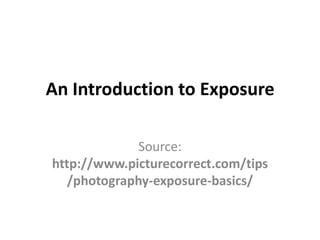
An introduction to exposure
- 1. An Introduction to Exposure Source: http://www.picturecorrect.com/tips /photography-exposure-basics/
- 2. • Exposure simply means allowing light to strike your film. • Aperture and f-numbers. The aperture is just a hole whose size can be varied to allow more or less light to pass through it. The size of apertures are expressed in f-numbers. • Shutter and Shutter Speeds. The shutter prevents light from reaching the film until the moment of exposure, when it opens for a predetermined time allowing light passing through the lens aperture to reach the film
- 3. • Shutter speeds are expressed in seconds or fractions of a second. Slow shutter speeds run into seconds while fast shutter speeds will be shorter than 1/500th of a second. • In normal photography shutter speeds will probably fall into the range 1/60th to 1/1000th of a second. • As you may have worked out, changing from one shutter speed to the next changes the exposure by one 'stop' in much the same way as changing the aperture.
- 4. • Exposure is the amount of light collected by the sensor in your camera during a single picture. If the shot is exposed too long the photograph will be washed out. • If the shot is exposed too short the photograph will appear too dark. • The two primary controls your camera uses for exposure are shutter speed (the amount of time the sensor is exposed to light) and aperture (the size of the lens opening that lets light into the camera). Shutter speeds are measured in seconds and more commonly fractions of a second.
- 5. • Shutter speeds are measured in seconds and more commonly fractions of a second. (1/2000 of a second is very fast and 8′ seconds is extremely slow). • Apertures are measured in something called f/stops (a very wide aperture is f/2.8 and a very small aperture is f/19).
- 6. • You might wonder why there is not just a constant shutter speed or a constant aperture so that you would only have to worry about one control. • The reason is that even though they both control the amount of light getting to the sensor they also control other aspects of the picture. • Shutter speed for example can be used to freeze subjects in midair with a fast speed or it can be used to blur water with a slow speed
- 7. • Aperture controls the depth-of-field which is what is in focus in the picture. Aperture can be used to draw attention to one subject (like the flower on the right) by blurring the background with a wide aperture (low f/stop). • Aperture can also be used to focus everything in a picture with a narrow aperture (high f/stop).
